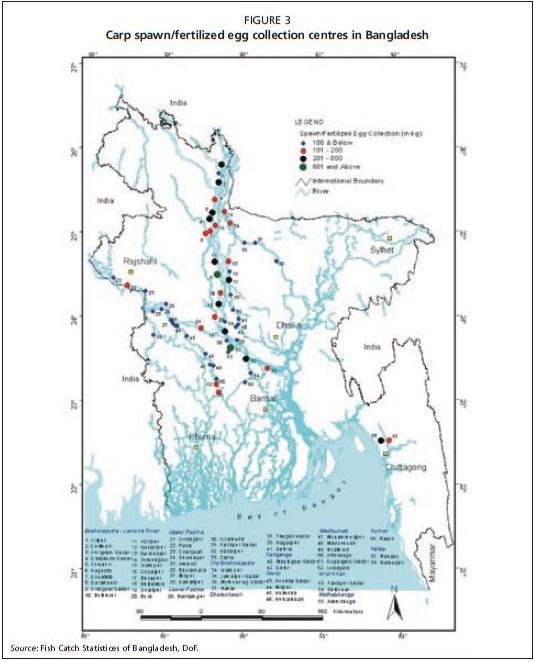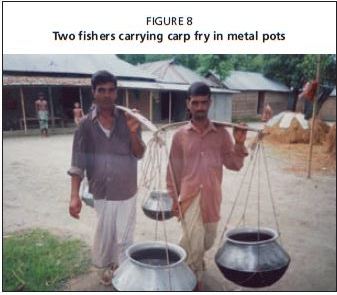MAJOR CARP FRY FISHERIES
All floodplain fish species in Bangladesh spawn in the pre-monsoon to monsoon months (March–October), the exact timing depending on the climatic conditions that affect the different species. All four species of carp breed during the monsoon and rivers play a vital role in their breeding functions. Therefore, rivers not only providing habitats for the capture fishery, but also support the very important major carp grow out, spawn and fry fisheries.
The collection of major carp spawn from rivers for sale to the aquaculture industry is an old practice in Bangladesh. Therefore, information related to places and time of carp spawn collection is well known. However, detailed information of all the spawn collecting sites in the country, with quantity and quality of spawn, and with relevant socioeconomic attributes is not well documented. The only reliable or usable source of carp spawn data in the country is the Fisheries Resource Survey System (FRSS) of the Department of Fisheries (DoF).
Spawn or fry collection has been the only source of initial support for the aquaculture or the culture fishery sector in Bangladesh until artificial spawning in hatcheries started in the early 1980s.
Fry collection sites
Of the various river systems from which the carp spawn is collected, three rivers and their tributaries are particularly important. These are Ganges-Padma (southwest), Brahmaputra-Januma (north central) and Halda (southeast) river systems. It is estimated that there are over 90 spawn collecting centers or points in the country’s three major river systems (Figure 3). Of the various points for spawn collecting and sales, the location in Sirajgonj on the Jamuna River is one of the most important sites.
FIGURE 3
Carp spawn/fertilized egg collection centres in Bangladesh

Source: Fish Catch Statistices of Bangladesh, DoF.
In June 1994 approximately 5 million taka (US$73 000) worth of spawn was sold or distributed for every single mile of the river fished.
Species of carp by river systems
The major carp species in the collected spawn from the Halda River are catla (C. catla) (70%), the remainder being rui (L. rohita) and mrigel (C. mrigala), with catla being the fastest growing Indian major carp species. The demand for Halda spawn remains very high compared to spawn from other river sites. Tsai and Ali (1987) analysed species composition of fingerlings raised from Halda spawn stocked and found that catla comprised 81.8 percent, while rui was 9.5 percent and mrigel was 8.7 percent. The fry captured a month later had a different composition, with catla, rui and mrigel being 23.5, 32.8 and 43.2 percent, respectively. This suggests that major spawning of catla takes place earlier than other two species in the Halda River, although these three species started spawning on the same dates and in same spawning grounds. The Halda adult carp fishery is also dominated by the abundance of catla followed by rui and mrigel.
TABLE 3
Species composition of spawn (excluding Hilsa spawn) in the Lohajang River in 1994
The spawn of other river systems (Ganges-Padma and Brhamaputra
Figure 4
minor carps (Labeo bata and Cirrhinus reba). A study on the species composition of spawn of Brahmaputra-Jamuna stock collected from the Lohajong River (a secondary tributary of Jamuna River) found a mix of species, as shown in
Table 3. Most of the spawn collected in the Lohajong
Decrease in natural catch and increase in artificial supply of Indian major carp spawn from 1984–2005

data), to 5 194 kilograms in the 1990s (mean of 10 years data), to only 2 255 kilograms in the 2000s (mean of 6 years data).
Degradation of natural breeding habitats
Flood Control Drainage and Irrigation (FCDI) projects have altered many important fish breeding and nursery areas in Bangladesh. The infrastructure built under FCDI projects, such as embankments, sluice gates and closures, not only reduced the wetland area but also blocked and/or obstructed the fish migration routes. As a result, migration for spawning, nursery and feeding areas has been seriously impacted, resulting in a decline in the carp fishery as a whole. The Farrakka barrage caused severe damage to the Upper Padma stock, hindering both adult migration to their breeding habitats and the subsequent drift of spawn downstream. This problem of free passage is further aggravated by the shortage of water in the dry season, leaving the fish vulnerable to fishing and natural causes. The stocks of mature wild fish have seriously declined, and this affects overall fish production, especially among major carp species that require 2 to 3 years to attain sexual maturity.
Destructive fishing practices, such as the increased use of fixed gears across rivers and canals during fish migration, the complete water drainage of the wetlands in the dry season, and the use of monofilament nylon gillnets have collectively impacted the capture fishery as a whole.
Fry sources
Over the last decade there has been a major shift in demand from wild-caught major carp spawn to hatchery-produced spawn. This has mainly been due to establishment of numerous private and government hatcheries and nurseries. The production capacity, especially that of the private facilities, has increased many fold, and their services and communications have also improved, thus providing a very attractive alternative to wild caught spawn. Furthermore, by purchasing hatchery-raised fry, the customer is assured of getting the desired species, whereas with wild-caught spawn there is often the risk of getting spawn that includes several fish species. However, many hatchery operators use poor quality broodstock, producing inferior quality fry, thus creating a negative image among potential customers.
Spawn fishing gears
Figure 5
View of a river bank in Bangladesh with a number of savar nets
Figure 6
Sketch of a typical savar net used in major rivers in Bangladesh for major carp spawn fishing

The major carp spawn fishing gear that has traditionally been used in the two major river systems (Ganges-Padma and Bhrhamaputra-Jamuna) is a funnel shaped fixed net, popularly called a “savar net”. This is a type of set bag net specially designed to fix the net at the shallow, gently sloping shoreline of the rivers, where the depth of water is negotiable without any aid.
The savar net is usually small, with a collection pocket at the tail end (Figures 5 and 6). The net is made of a fine mesh that traps tiny eggs or spawn that drift with the water flow during the monsoon months. A water flow in the range of 20–60 cm/sec. is desirable for spawn trapping (Kumar, 1992). The accumulated spawn are collected and held in water for sale and transportation. These nets are locally made and easily available, costing approximately US$10 each.
Natural fish spawn collection method
The savar spawn collection nets are placed in several rows near the shore, facing the current, at intervals of 2–8 m, and each row may have between 3–15 nets. The front extensions of the adjacent nets are tied together to the same bamboo pole, the poles having been set in the river at the beginning of the fishing season to mark the area of each savar site. The upper edge of the tail bag is kept about 4–5 cm above the water surface to prevent the escape of spawn.
When the river water rises to a level favorable for spawn collection, a few test nets are set. As soon as the desired spawns are spotted in the test nets, all the nets are set rapidly in the river, and spawn collection begins in earnest. A collector walks from one net to another at regular intervals to scoop up spawn from the tail bag and place it in an earthen or aluminum pot known as patil or handi (Figure 7). The spawn are subsequently sieved through a screen box and kept in hapas nets fixed near the spawn collecting sites to await sale.
Figure 7
A – Fixing a savar net at the shoreline of a river;
B – A group of savar nets;
C – Collection of spawn from a savar tail end;
D – The collected spawn is frequently checked;
E – Spawn waiting in hapas for sale or transport to nurseries

Boats
Locally made boats of various sizes and shapes, mechanized and non-mechanized, are used for spawn collecting and transport. The most commonly used boat is small and normally carries 1–2 fishers while larger mechanized boats may carry up to 3 fishers and are usually preferred as the collected spawn can be transported quickly to the sale sites.
Handling and transportation of spawn
Usually a spawn collector operates more than one net, depending on the suitability of the sites and extent of spawn availability. Depending on silt load, water depth and
Figure 8
Two fishers carrying carp fry in metal pots

spawn pulses, the operators remove, clean and reattach the nets as needed. During strong spawn pulses the spawn is scooped from the net traps every 15 to 30 minutes. The collected spawn is then transferred to aluminum or clay containers partly filled with water (Figure 8). The spawn is then sieved through mosquito netting, to separate major carp spawn from debris and larger fish. The spawn is then conditioned in either hapas or in small earthen ponds before transportation.
The spawn collected from rivers is generally a mixture of spawn of major carps, minor carps, and other fishes. The operators often try to segregate the major carp spawn from the spawn and fry of other fishes either before or after conditioning.